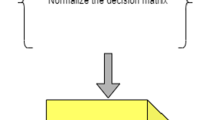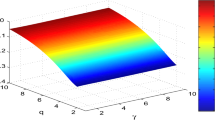Abstract
The linguistic \(q\)-rung orthopair fuzzy (L\(q\)-ROF) set (L\(q\)-ROFS) is an important implement in the research area in modelling vague decision information by incorporating the advantages of \(q\)-rung orthopair fuzzy sets with linguistic variables. To effectively fuse the L\(q\)-ROF information, this paper introduces a series of L\(q\)-ROF power Heronian mean operators with their weighted variants based on Archimedean operations. The defined operators meet certain important characteristics such as they can provide generality and flexibility in the aggregation process, model uncertainty of decision-making with interrelated attributes, and the influence of unreasonable attribute values can also be reduced by them. A generalized distance measure and an entropy measure were defined for L\(q\)-ROFSs, subsequently. Afterwards, a multi-attribute group decision-making approach under L\(q\)-ROF context, where the information about decision-makers’ and attribute weights might be known or unknown, is designed utilizing individual expressions of the proposed operators. The developed approach includes a TOPSIS‐based algorithm and an entropy-based algorithm in order to compute the weight of decision-makers’ and attributes, respectively. Finally, the proposed method’s feasibility is validated by solving a financial strategy-making problem, and its superiority is demonstrated via some detailed comparisons.













Similar content being viewed by others
Data Availability
All the required data are available within the article.
References
Abu AO (2017) Adaptation of reproducing kernel algorithm for solving fuzzy Fredholm–Volterra integrodifferential equations. Neural Comput Appl 28:1591–1610
Abu Arqub O, Singh J, Alhodaly M (2021a) Adaptation of kernel functions-based approach with Atangana–Baleanu–Caputo distributed order derivative for solutions of fuzzy fractional Volterra and Fredholm integrodifferential equations. Math Methods Appl Sci. https://doi.org/10.1002/mma.7228
Abu Arqub O, Singh J, Maayah B, Alhodaly M (2021b) Reproducing kernel approach for numerical solutions of fuzzy fractional initial value problems under the Mittag–Leffler kernel differential operator. Math Methods Appl Sci. https://doi.org/10.1002/mma.7305
Alshammari M, Al-Smadi M, Arqub OA, Hashim I, Alias MA (2020) Residual series representation algorithm for solving fuzzy duffing oscillator equations. Symmetry 12(4):572
Atanassov KT (1986) Intuitionistic fuzzy sets. Fuzzy Sets Syst 20(1):87–96
Beliakov G, Pradera A, Calvo T (2007) Aggregation functions: a guide for practitioners. Springer, Heidelberg
Biswas A, Deb N (2021) Pythagorean fuzzy Schweizer and Sklar power aggregation operators for solving multi-attribute decision-making problems. Granul Comput 6:991–1007
Çağlar M, Gürel S (2019) Impact assessment based sectoral balancing in public R&D project portfolio selection. Soc Econ Plan Sci 66:68–81
Chen J, Zhang R (2022) Pythagorean fuzzy linguistic power generalized maclaurin symmetric mean operators and their application in multiple attribute group decision-making. IEEE Access 10:115033–115050
Deb N, Biswas A (2021) On developing Pythagorean fuzzy dombi geometric bonferroni mean operators with their application to multicriteria decision making. In: Pythagorean fuzzy sets. Springer, Singapore, pp. 209–234
Deb N, Sarkar A, Biswas A (2022) Linguistic q-rung orthopair fuzzy prioritized aggregation operators based on Hamacher t-norm and t-conorm and their applications to multicriteria group decision making. Arch Control Sci 32(2):451–484
Garg H (2018) Linguistic Pythagorean fuzzy sets and its applications in multiattribute decision-making process. Int J Intell Syst 33(6):1234–1263
Garg H, Arora R (2021) Generalized Maclaurin symmetric mean aggregation operators based on Archimedean t-norm of the intuitionistic fuzzy soft set information. Artif Intell Rev 54(4):3173–3213
Garg H, Kumar K (2018a) Group decision making approach based on possibility degree measures and the linguistic intuitionistic fuzzy aggregation operators using Einstein norm operations. J Mult Val Log Soft Comput 31(1–2):175–209
Garg H, Kumar K (2018b) Some aggregation operators for linguistic intuitionistic fuzzy set and its application to group decision-making process using the set pair analysis. Arab J Sci Eng 43:3213–3227
Gayen S, Sarkar A, Biswas A (2022) Development of q-rung orthopair trapezoidal fuzzy Hamacher aggregation operators and its application in MCGDM problems. Comput Appl Math 41(6):263
Herrera F, Herrera-Viedma E, Verdegay JL (1996) A model of consensus in group decision making under linguistic assessments. Fuzzy Sets Syst 78(1):73–87
Klement EP, Mesiar R (2005) Logical, algebraic, analytic, and probabilistic aspects of triangular norms. Elsevier, New York
Klir G, Yuan B (1995) Fuzzy sets and fuzzy logic: theory and applications. Prentice Hall, Upper Saddle River
Kumar K, Chen SM (2022) Multiple attribute group decision making based on advanced linguistic intuitionistic fuzzy weighted averaging aggregation operator of linguistic intuitionistic fuzzy numbers. Inf Sci 587:813–824
Lin M, Huang C, Xu Z (2019a) TOPSIS method based on correlation coefficient and entropy measure for linguistic Pythagorean fuzzy sets and its application to multiple attribute decision making. Complexity 2019:6967390
Lin M, Li X, Chen L (2019b) Linguistic q-rung orthopair fuzzy sets and their interactional partitioned Heronian mean aggregation operators. Int J Intell Syst 35(2):217–249
Lin M, Wei J, Xu Z, Chen R (2018) Multiattribute group decision-making based on linguistic Pythagorean fuzzy interaction partitioned Bonferroni mean aggregation operators. Complexity 2018:9531064
Liu P, Liu X (2017) Multiattribute group decision making methods based on linguistic intuitionistic fuzzy power Bonferroni mean operators. Complexity 2017:1–15
Liu P, Liu W (2018a) Scaled prioritized operators based on the linguistic intuitionistic fuzzy numbers and their applications to multi-attribute decision making. Int J Fuzzy Syst 20(5):1539–1550
Liu P, Liu W (2018b) Multiple-attribute group decision-making based on power Bonferroni operators of linguistic q-rung orthopair fuzzy numbers. Int J Intell Syst 34(4):652–689
Liu P, Liu W (2019) Multiple-attribute group decision-making method of linguistic q-rung orthopair fuzzy power Muirhead mean operators based on entropy weight. Int J Intell Syst 34(8):1755–1794
Liu P, Liu J (2020) A multiple attribute group decision-making method based on the partitioned Bonferroni mean of linguistic intuitionistic fuzzy numbers. Cogn Comput 12:49–70
Liu P, Qin X (2017) Power average operators of linguistic intuitionistic fuzzy numbers and their application to multiple-attribute decision making. J Intell Fuzzy Syst 32(1):1029–1043
Liu P, Liu J, Merigó JM (2018) Partitioned Heronian means based on linguistic intuitionistic fuzzy numbers for dealing with multi-attribute group decision making. Appl Soft Comput 62:395–422
Liu Y, Liu J, Qin Y (2020a) Pythagorean fuzzy linguistic Muirhead mean operators and their applications to multiattribute decision-making. Int J Intell Syst 35:300–332
Liu Y, Qin Y, Xu L, Liu HB, Liu J (2019a) Multiattribute group decision-making approach with linguistic Pythagorean fuzzy information. IEEE Access 7:143412–143430
Liu P, Zhu B, Wang P, Shen M (2020b) An approach based on linguistic spherical fuzzy sets for public evaluation of shared bicycles in China. Eng Appl Artif Intell 87:103295
Liu Z, Xu H, Yu Y, Li J (2019b) Some q-rung orthopair uncertain linguistic aggregation operators and their application to multiple attribute group decision making. Int J Intell Syst 34(10):2521–2555
Luo SZ, Xing LN, Ren T (2022) Performance evaluation of human resources based on linguistic neutrosophic maclaurin symmetric mean operators. Cogn Comput 14(2):547–562
Nguyen HT, Walker EA (1997) A first course in fuzzy logic. CRC Press, Boca Raton
Peng D, Wang J, Liu D, Liu Z (2016) The similarity measures for linguistic -rung orthopair fuzzy multi-criteria group decision making using projection method. IEEE Access 7:176732–176745
Rong Y, Pei Z, Liu Y (2020) Linguistic Pythagorean Einstein operators and their application to decision making. Information 11(1):46
Sajjad Ali Khan M, Sultan Khan A, Ali Khan I, Hussain F, Mashwani WK (2021) Linguistic interval-valued q-rung Orthopair fuzzy TOPSIS method for decision making problem with incomplete weight. J Intell Fuzzy Syst 40(3):4223–4235
Sarkar A, Biswas A (2019) Multicriteria decision-making using Archimedean aggregation operators in Pythagorean hesitant fuzzy environment. Int J Intell Syst 34(7):1361–1386
Sarkar B, Biswas A (2021a) Linguistic Einstein aggregation operator-based TOPSIS for multicriteria group decision making in linguistic Pythagorean fuzzy environment. Int J Intell Syst 36(6):2825–2864
Sarkar A, Biswas A (2021b) Dual hesitant q-rung orthopair fuzzy Dombi t-conorm and t-norm based Bonferroni mean operators for solving multicriteria group decision making problems. Int J Intell Syst 36(7):3293–3338
Sarkar A, Biswas A (2021c) Interval-valued dual hesitant fuzzy prioritized aggregation operators based on Archimedean t-conorm and t-norm and their applications to multi-criteria decision making. Arch Control Sci 31(1):213–247
Sarkar A, Deb N, Biswas A (2021) Uncertainty evaluations through interval-valued Pythagorean hesitant fuzzy Archimedean aggregation operators in multicriteria decision making. Intell Decis Technol. https://doi.org/10.3233/IDT-200065
Sarkar A, Deb N, Biswas A (2023) Weighted dual hesitant q-rung orthopair fuzzy sets and their application in multicriteria group decision making based on Hamacher operations. Comput Appl Math 42(1):1–40
Singh S, Ganie AH (2022) On a new picture fuzzy correlation coefficient with its applications to pattern recognition and identification of an investment sector. Comput Appl Math 41(1):1–35
Sun B, Tong S, Ma W, Wang T, Jiang C (2021) An approach to MCGDM based on multi-granulation Pythagorean fuzzy rough set over two universes and its application to medical decision problem. Artif Intell Rev pp 1–27
Sykora S (2009) Mathematical means and averages: generalized Heronian means. Sykora S. Stan’s Library, Castano Primo
Teng F, Du C, Shen M, Liu P (2022) A dynamic large-scale multiple attribute group decision-making method with probabilistic linguistic term sets based on trust relationship and opinion correlation. Inf Sci 612:257–295
Xu Z (2005) Deviation measures of linguistic preference relations in group decision making. Omega 33(3):249–254
Yager RR (2001) The power average operator. IEEE Trans Syst Man Cybern A 31(6):724–731
Yager RR (2013) Pythagorean fuzzy subsets. In: Pedrycz W, Reformat M (eds) Proceedings of the Joint IFSA World Congress and NAFIPS Annual Meeting, IEEE. Edmonton, Canada, pp 57‐61
Yager RR (2014) Pythagorean membership grades in multicriteria decision-making. IEEE Trans Fuzzy Syst 22(4):958–965
Yager RR (2017) Generalized orthopair fuzzy sets. IEEE Trans Fuzzy Syst 25(5):1222–1230
Yang Z, Garg H (2021) Interaction power partitioned maclaurin symmetric mean operators under q-rung orthopair uncertain linguistic information. Int J Fuzzy Syst. https://doi.org/10.1007/s40815-021-01062-5
Zadeh LA (1965) Fuzzy sets. Inf Control 8(3):338–356
Zadeh LA (1975) The concept of a linguistic variable and its application to approximate reasoning-I. Inf Sci 8(3):199–249
Zhang H (2014) Linguistic intuitionistic fuzzy sets and application in MAGDM. J Appl Math 2014:1–11
Zhang S, Wang C, Liao P, Xiao L, Fu T (2022) Wind speed forecasting based on model selection, fuzzy cluster, and multi-objective algorithm and wind energy simulation by Betz’s theory. Expert Syst Appl 193:116509
Zhong Y, Gao H, Guo X, Qin Y, Huang M, Luo X (2019) Dombi power partitioned Heronian mean operators of q-rung orthopair fuzzy numbers for multiple attribute group decision making. PLoS ONE 14(10):e0222007
Funding
No funding is associated with this article.
Author information
Authors and Affiliations
Corresponding author
Ethics declarations
Conflicts of interest
The authors declare that there are no potential conflicts of interest.
Human and Animals participants
The authors declare that no human participants and/ or animals are involved with this article.
Informed consent
Since all authors consented for submission of this article to Soft Computing, no further consent is required for other regarding this article.
Additional information
Publisher's Note
Springer Nature remains neutral with regard to jurisdictional claims in published maps and institutional affiliations.
Rights and permissions
Springer Nature or its licensor (e.g. a society or other partner) holds exclusive rights to this article under a publishing agreement with the author(s) or other rightsholder(s); author self-archiving of the accepted manuscript version of this article is solely governed by the terms of such publishing agreement and applicable law.
About this article
Cite this article
Deb, N., Sarkar, A. & Biswas, A. Development of Archimedean power Heronian mean operators for aggregating linguistic q-rung orthopair fuzzy information and its application to financial strategy making. Soft Comput 27, 11985–12020 (2023). https://doi.org/10.1007/s00500-023-08015-0
Accepted:
Published:
Issue Date:
DOI: https://doi.org/10.1007/s00500-023-08015-0




